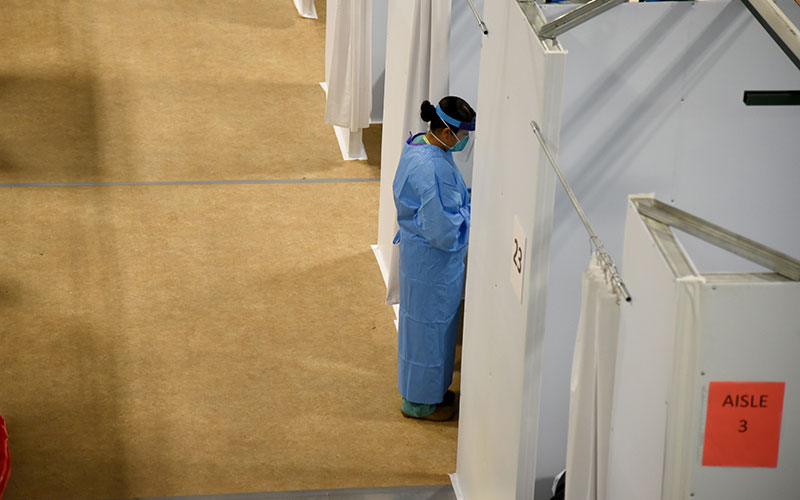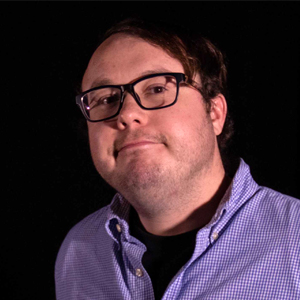
The Arizona National Guard is among the partners helping with staffing issues cropping up in Arizona. In this June 2 photo, Spc. Paige Curtiss, 253rd Engineer Battalion, speaks to a COVID-19 patient at a care facility on the Navajo Nation Reservation in Chinle. (Photo courtesy of Tech. Sgt. Michael Matkin/U.S. Air National Guard)
PHOENIX – Arizona led the U.S. in the growth of confirmed coronavirus cases Wednesday, and if states were viewed as their own countries, the Grand Canyon State would lead the world, according to an alarming analysis by The New York Times. State officials pushed back against that characterization Wednesday, but Arizona doctors fear the situation could worsen.
For every 1 million Arizona residents, 3,300 cases of COVID-19 have been detected over the past seven days, the Times reported.
Relying on data from Johns Hopkins University, the analysis also revealed that Arizona has the country’s highest daily percentage of positive coronavirus cases, with more than 25% of tests showing a positive result.
The findings echo Arizona’s last place ranking among 50 states in the Harvard Global Health Institute’s COVID-19 risk assessment tool on Wednesday.
Gov. Doug Ducey’s office refuted aspects of the Times analysis Wednesday.
“There is no question that Arizona is experiencing a significant number of COVID cases,” spokesperson Patrick Ptak wrote in an email. But he said characterizations that Arizona is the “worst in the world lack context and are misleading and inaccurate.”
Ptak refuted the idea that Arizona is the worst in certain categories, arguing, for example, that Brazil has completed only one-sixth the number of tests per 100,000 people, and Peru has a nearly 40% positivity testing rate.
The second worst state for growth in new cases was Florida, with 2,700 cases per million residents, according to the Times analysis. South Carolina was third, with 2,300 cases. Bahrain is the first country to appear on the list, at No. 4, with 2,200 cases per million residents.
Arizona doctors and health care workers have raised the alarm about the need for more staffing, testing and personal protective gear across the state in recent weeks. Masks and social distancing are a must, according to Dr. Shad Marvasti and other experts.
“You need to really do both in order to mitigate, and ultimately, hopefully suppress the spread of COVID-19,” said Marvasti, the director of public health, prevention and health promotion at the University of Arizona College of Medicine Phoenix.
Marvasti told Cronkite News he doesn’t agree with how the state moved away from face masks and social distancing, which he said were more widely used during Arizona’s stay-at-home order, and he believes more must be done to help reverse course before the state becomes an epicenter of infection.
“This basically puts us to where New York and Italy were at one point, just to give perspective in terms of where we’re at,” Marvasti said. “If we continue, obviously, we’re going to get to very similar circumstances with respect to rationing health care, and issues related to hospital beds and medical supplies.”
To slow the spread of the illness, New York City did a phased reopening and now is in phase 3, which means outdoor dining, nail salons and other services have returned. Since hitting records high in March, Italy, too, has minimized spread, according to the Times.
Arizona can replicate that success, Marvasti said.
“If you look at New York and Italy today, after several months and concerted efforts that they’ve made, and following the public health guidelines, they are now doing really well in terms of their numbers. That’s where we really want to go.”
Marvasti said Arizona is paying the price for not taking the time necessary to avoid the spread of COVID-19. The state reopened after Ducey’s stay-home order expired May 15, but he ordered some business to shut down again on June 29, when he also banned large gatherings and allowed county and city officials to require face masks in public. Since then, officials have been scrambling to enforce mask mandates and adequate social distancing in public places and businesses.
“We never really ended the first wave,” Marvasti said. “We had a little bit of a decrease, which worked because of the first shutdown, but then we had a surge because we rushed back to normal too quickly.”
He wants Ducey and state health experts to reevaluate the state’s approach, which closed only certain businesses, such as gyms and bars.
“The science tells us that being inside enclosed settings with poor ventilation is really the worst place in terms of increasing risk for COVID-19,” Marvasti said. “I think we really need to look closely at all our options, and we shouldn’t shy away from another shutdown if that’s what it takes to control the spread and save lives.”
As of Wednesday, July 8, the Arizona Department of Health Services reported 3,520 new cases of COVID-19, bringing the total to 108,614, and 36 new deaths, pushing the death toll to 1,963. It said 15,219 tests for COVID-19 have been completed in public and private labs in Arizona, and 11.4% of tests have come back positive for the virus that causes the disease.
Navajo leaders highlight difficulties in virtual hearing
Navajo President Jonathan Nez and other tribal leaders urged federal authorities to address the urgent needs of tribal communities during a virtual hearing before the House Energy and Commerce Committee on Wednesday. Indian Country Today reported federal funding inequities continue to “deny tribes the same access to health care, broadband, electricity and running water that most Americans enjoy.” Data released Tuesday by Nez’s office reported 27 new cases of COVID-19, a single death, and 5,650 recoveries.
Pima County COVID-19 patients transferred for treatment
COVID-19 patients from Pima County have been sent to Phoenix or even other states because of shortages in hospital staffing, equipment or bed space near their homes. Patients have been sent as far as San Diego, Albuquerque, New Mexico, and Las Vegas, according to Tucson.com.
As Pima County cases rose dramatically over the past two months, the situation became critical last week, said Dr. Theresa Cullen, the county’s health director. A patient needing a ventilator for more than a day, and other instances when hospitals cannot provide long-term, can initiate a referral.
More Phoenix firefighters test positive as COVID-19 calls mount
Seventy-seven members of the Phoenix Fire Department – nearly all of them firefighters – have tested positive for COVID-19, according to ABC15. Those who test positive must quarantine, as should anyone with whom they had contact, Capt. Rob McDade said.
To replace the quarantined firefighters, a mix of extra shifts and staffing only critical positions is being deployed. ABC15 said about half of the recent service calls for the city’s busiest station were suspected COVID-19 or COVID-19 positive cases.
Can Arizona schools reopen safely?
Some Arizona parents and teachers worry schools won’t be able to safely accommodate the return of students to in-person classes this fall. Earlier this week, Cronkite News reported that a White House panel of parents, teachers and school administrators said reopening schools should be the nation’s top priority.

